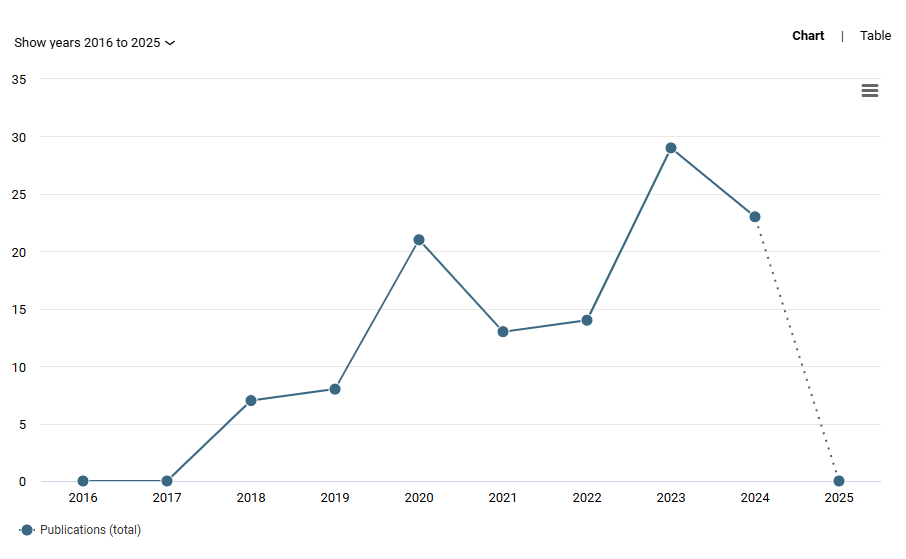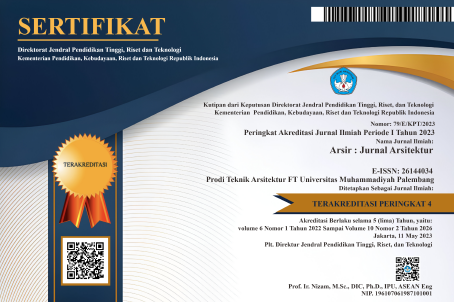Analisis Implementasi Elemen Interior di SLB-B YRTRW Surakarta Berdasarkan Konsep Deaf Space
DOI:
https://doi.org/10.32502/arsir.v8i1.118Kata Kunci:
implementasi, SLB-B, Karakteristik tunarungu, elemen interior, Deaf SpaceAbstrak
Sekolah Luar Biasa Tunarungu (SLB-B) Yayasan Rehabilitas Tuna Rungu Wicara (YRTRW) merupakan salah satu yayasan pendidikan anak tunarungu yang ada di Surakarta. Penyandang tunarungu memiliki keterbatasan kemampuan mendengar dan menerima informasi secara verbal, sehingga penglihatan menjadi faktor utama bagi mereka dalam mengumpulkan informasi. Kurangnya kebutuhan yang ideal bagi anak tunarungu dalam penggunaan fasilitas umum dari segi kenyamanan serta keamanan, sehingga hal ini menjadi pertimbangan dalam pengembangan fasilitas umum. Khususnya fasilitas pendidikan bagi anak penyandang tunarungu di Surakarta yang belum sepenuhnya ideal karena keterbatasan manfaat dan fungsi elemen suatu ruang. Hal ini dapat disebabkan karena beberapa faktor permasalahan yang menjadi karakteristik tunarungu yang perlu dikaitkan dalam pengembangan elemen interior agar dapat memberikan solusi yang tepat untuk tunarungu dalam melakukan aktivitas secara optimal dan mandiri. Penelitian ini dilakukan untuk mengkaji ulang desain elemen interior pada SLB-B YRTRW Surakarta. Penelitian ini menggunakan metode deskriptif kualitatif dimana informasi dikumpulkan melalui observasi, wawancara, dokumentasi, dan dianalisis dengan studi literatur. Hasil dari penelitian ini menunjukkan beberapa kekurangan dalam rancangan desain interior SLB-B YRTRW Surakarta ditinjau dalam 5 prinsip The Deaf Space Design Guidelines oleh Hansel Bauman, terdapat 3 prinsip yang belum terpenuhi yaitu Space and Proximity, Sensory Reach, dan Mobility and Proximity.
Unduhan
Diterbitkan
Cara Mengutip
Terbitan
Bagian
Lisensi
Hak Cipta (c) 2024 Anna Pratista Andanitya

Artikel ini berlisensiCreative Commons Attribution-ShareAlike 4.0 International License.
Arsir: Jurnal Arsitektur (AJA) have CC-BY-SA or an equivalent license as the optimal license for the publication, distribution, use, and reuse of scholarly work.
Authors who publish Arsir: Jurnal Arsitektur (AJA) agree to the following terms: Authors retain copyright and grant the Arsir: Jurnal Arsitektur (AJA) right of first publication with the work simultaneously licensed under a Creative Commons Attribution License (CC BY-SA 4.0) that allows others to share (copy and redistribute the material in any medium or format) and adapt (remix, transform, and build upon the material) the work for any purpose, even commercially, with an acknowledgement of the work's authorship and initial publication in Arsir: Jurnal Arsitektur (AJA). Authors are able to enter into separate, additional contractual arrangements for the non-exclusive distribution of the journal's published version of the work (e.g., post it to an institutional repository or publish it in a book), with an acknowledgement of its initial publication in Arsir: Jurnal Arsitektur (AJA). Authors are permitted and encouraged to post their work online (e.g., in institutional repositories or on their website) prior to and during the submission process, as it can lead to productive exchanges as well as earlier and greater citation of published work (see The Effect of Open Access).
![]()
Work is distributed below This work is licensed under a Creative Commons Attribution-ShareAlike 4.0 International License.




